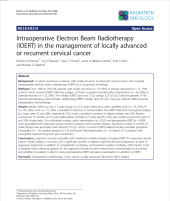OVERVIEW
To report outcomes in women with locally recurrent or advanced cervical cancer who received intraoperative electron beam radiotherapy (IOERT) as a component of therapy.
METHODS AND MATERIALS
From 1983 to 2010, 86 patients with locally recurrent (n = 73, 85%) or primary advanced (n = 13, 15%) cervical cancer received IOERT following surgery. Common surgeries included pelvic exenteration (n = 26; 30%) or sidewall resection (n = 22; 26%). The median IOERT dose was 15 Gy (range, 6.25-25 Gy). Sixty-one patients (71%) received perioperative external beam radiotherapy (EBRT; median dose, 45 Gy). Forty-one patients (48%) received perioperative chemotherapy.
RESULTS
Median follow-up was 2.7 years (range, 0.1-25.5 years). Resections were classified as R0 (n = 35, 41%), R1
(n = 30, 35%), or R2 (n = 21, 24%). Cumulative incidences of central (within the IOERT field) and locoregional relapse at 3 years were 23 and 38%, respectively. The 3-year cumulative incidence of distant relapse was 43%. Median survival was 15 months, and 3-year Kaplan-Meier estimates of cause-specific (CSS) and overall survival (OS) were 31 and 25%, respectively. On multivariate analysis, pelvic exenteration (p = 0.02) and perioperative EBRT (p = 0.009) were associated with improved central control in patients with recurrent disease. Recurrence within 6 months of initial therapy was associated with reduced CSS (p = 0.001). Common IOERT-related toxicities included peripheral neuropathy (n = 16), ureteral stenosis (n = 4), and bowel fistula/perforation (n = 4). Eleven of 16 patients with neuropathy required long-term pain medication.
CONCLUSION
Long-term survival is possible with combined modality therapy including IOERT for advanced cervical cancer. Distant relapse is common, yet a significant number of patients experienced local progression in spite of aggressive treatment. In addition to consideration of disease- and treatment-related morbidity, other factors to be considered when selecting patients for this approach include the time interval from initial therapy to recurrence and whether the patient is able to receive perioperative EBRT and pelvic exenteration in addition to IOERT.
